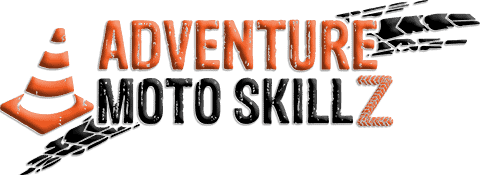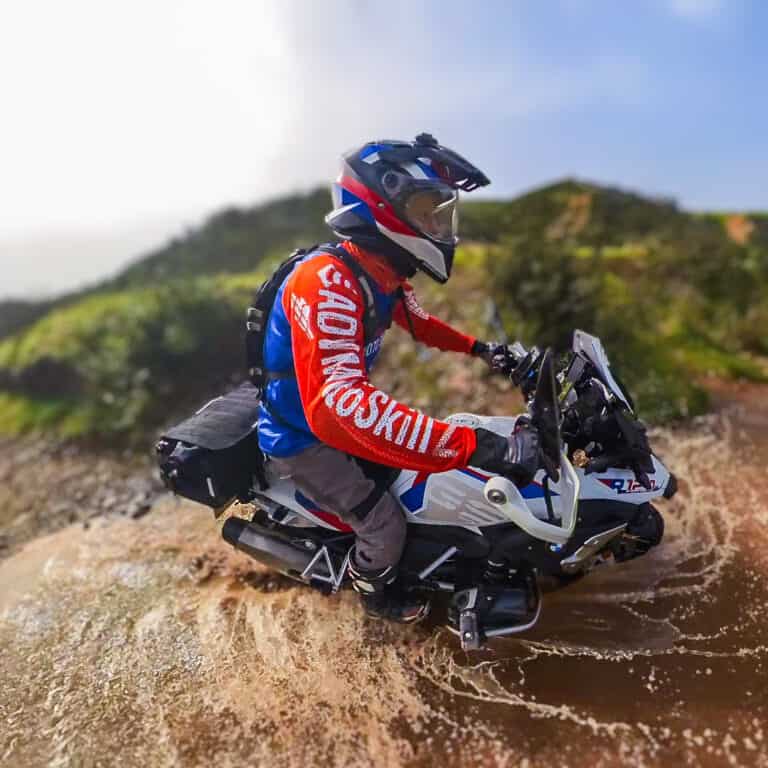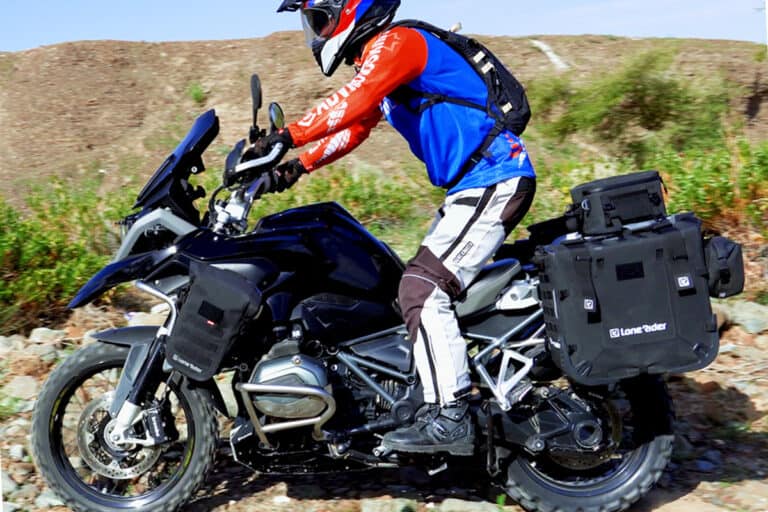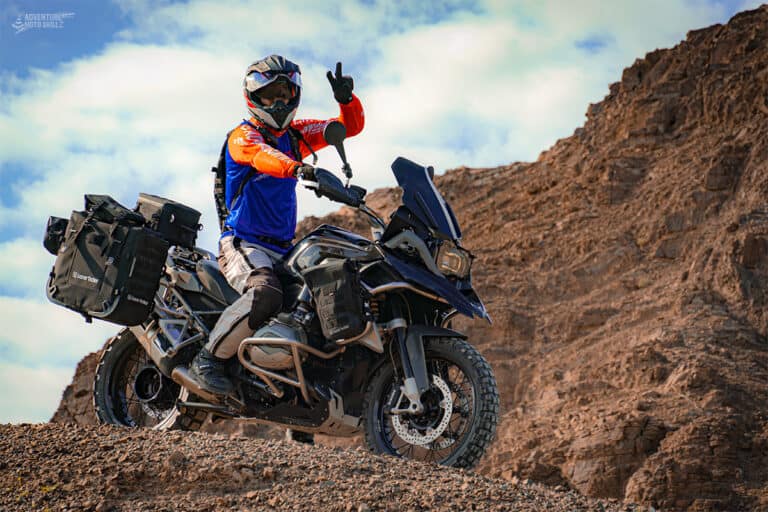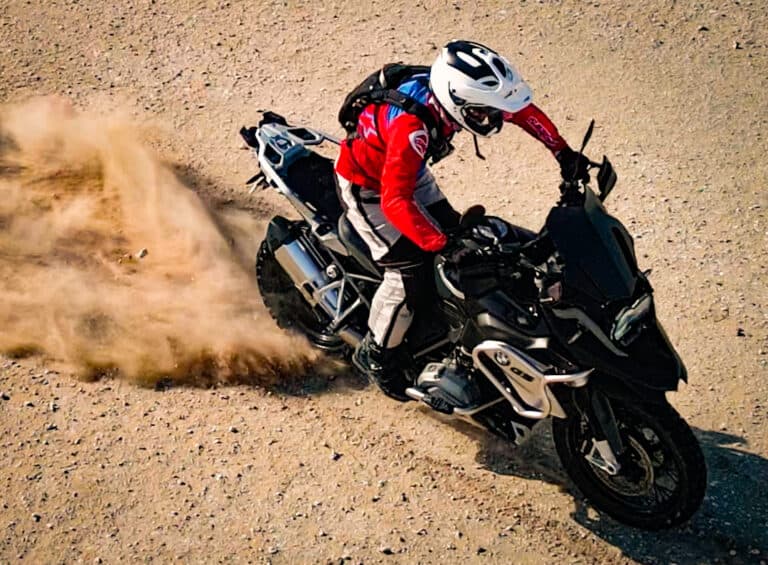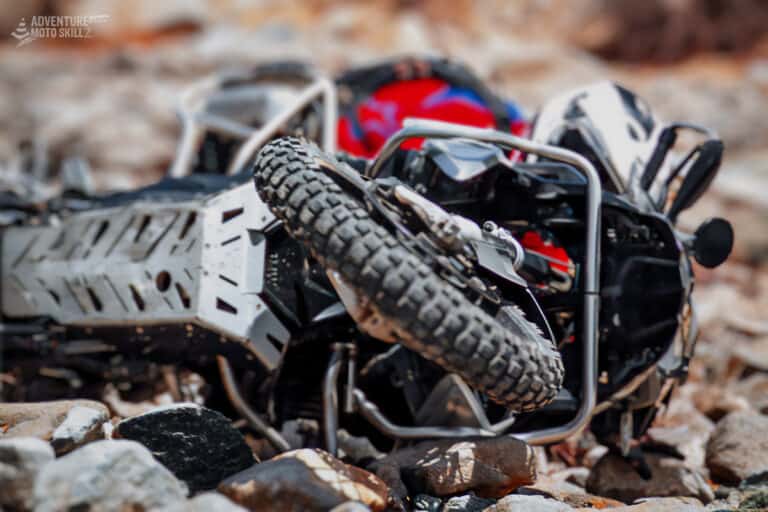Riding Off-Road Hills: ADV Motorcycle Body Position
Not all hills are created equal.
We will encounter rolling hills, sharp peaks, and everything in between when riding off-road. Uphill and downhill riding can be tricky, so adopting the correct body positioning is vital to make it as smooth and safe as possible.
Successful hill climbs and descents on an ADV or dual sport motorcycle include adopting the correct body positioning for that particular event. Hill base, hill face, and hill summit each require specific postural adaptations.

When off-road conditions are loose or technical, the correct body posture is vital in helping to keep your balance and maintain traction. This blog post will discuss how to safely and efficiently ride hills on your ADV or dual sport motorcycle safely and efficiently.
This post may contain Affiliate Links. Please see our Privacy & Disclosure Policy for more details.
What is an Off-Road Hill?
National Geographic says a hill is “a piece of land that rises higher than everything surrounding it.” Hills are formed by nature slowly over time. Fun fact: hills humans have made are technically called “mounds.” So, this blog post will keep the focus on naturally made hill formations.
If you want to understand the geology of hills a bit better, check out this National Geographic article.
Let’s cover some of the terms and definitions of hills so that we are all on the same page as we discuss each area.
The bottom of a hill is referred to as the base. The base of a hill will serve as our approach for a hill climb and the exit point for a hill descent.
The top of a hill is called the summit or crest. This is the highest point of the hill and where the bike transitions from going uphill to going downhill.
All hill real estate between the base and summit is called the face. The hill face can have as many different looks (as you or I can)! They can be smooth and welcoming or a bit rough and hard to handle.

Top-quality gear for your next adventure
Used and recommended by ADVMotoSkillZ
How off-road hills affect body posture on an ADV motorcycle
The steepness and available traction of the hill will directly influence the type of body positioning we need to adopt. Sand, wet mossy rocks, or small pebbly gravel will all have differing traction offerings that we may have to negotiate.
Any conversation about body positioning on hills needs to mention gravity as well. On a steep hill climb, you can feel the pull of gravity weighting the rear wheel and lightening the front end. It can be an uneasy sensation, feeling like the front tire will float up off the ground.
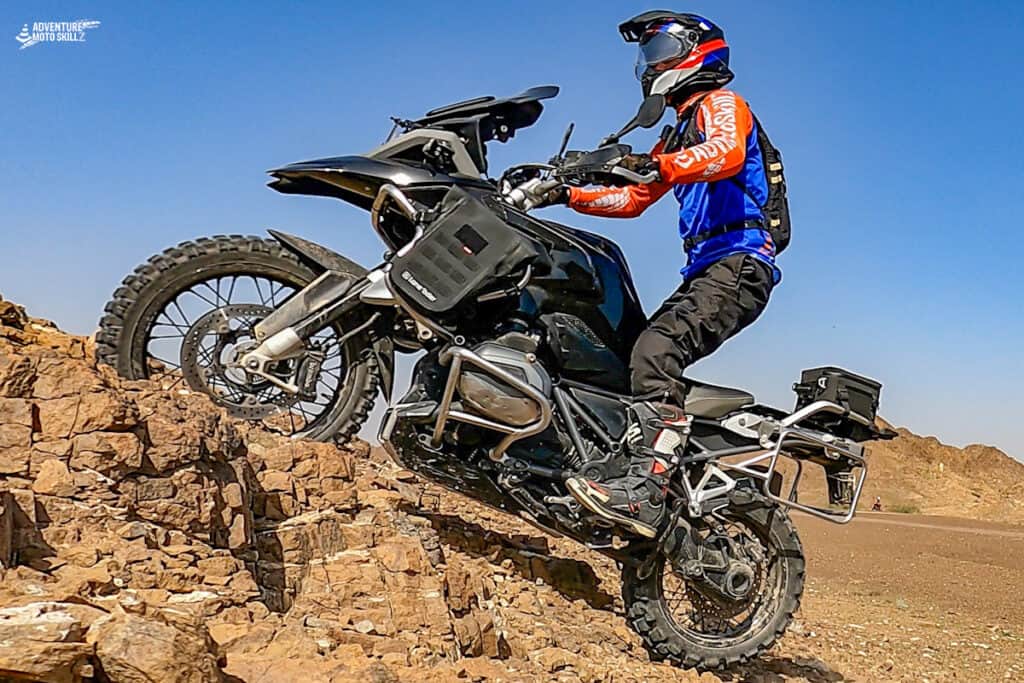
Hitting a steep uphill with too much speed can be disastrous. This creates a big risk of gravity pulling you back so quickly that you whiskey throttle while attempting to hold on.
Likewise, on a steep descent, gravity will pull strongly on the bike’s front end while lightening the rear. Improper body positioning coupled with poor control inputs can result in a rider going over the bars.
With so much focus on getting the climb and the descent right, please do not overlook the crest of the hill itself. The crest’s angle, thickness, and terrain quality will require various posture changes. As the motorcycle transitions from an uphill to a downhill trajectory, gravitation forces on your body can sometimes be extreme if you are going fast.
Improving ADV motorcycle body position on off-road hills
Hill Climbs
I recommend standing riding posture for most off-road hill climbs. Standing posture allows for the best line of vision as you approach the base of the hill. This helps you choose the best line to ensure success over the hill. This tall view also improves your ability to see over the crest of a hill as the bike transitions.
By standing up on the pegs prior to the hill approach, body position can maximally influence the bike. It would look like this:
- Neutral standing posture upon approach
- At the base of the hill, quickly squat to stomp down on the pegs and compress the suspension
- Time the suspension rebound to rise back up just as you begin the climb
- At this moment, braaap while in 2nd gear and lean body weight forward
For short climbs, these actions will bring you straight up to the crest, and you will need to roll off the throttle appropriately. Longer and/or steeper climbs will need additional body posture movement to maintain traction on the rear wheel. This rear tire grip can be improved with a slight transition of the hips rearward during the climb.
Hill Cresting (transitioning from uphill to downhill)
Most off-road hills are blind. This means that although we can see the uphill face as we approach, we can not see the downslope. This fact makes the cresting of the hill the most important to be prepared for.
By controlling speed, we create more time to scan, identify hazards and react. Scrubbing off speed upon approaching the hill summit also reduces our chances of sending the bike into an unexpected jump.

Choosing a line up the face of the hill at an angle will also give more time to look over the summit and make a plan. If you travel up the face at an angle, then be ready to use your body positioning to counterbalance the bike as it crests the hill. Remember that gravity will pull the bike towards the base of the hill, so counterbalancing the bike on the crest side is essential.
As you approach the summit from a forward-leaning standing position, get ready to shift your body weight. As soon as the front tire crosses over the top, you will slowly begin to transition into a neutral standing posture.
As the bike’s downward angle increases, your body moves into a standing attack position. The amount of squat and rearward shift of body weight is determined by the pitch of the hill.
Hill Descent
As the bike crosses over the hill crest and both tires have cleared the peak, you are officially on the downward face. Lower legs from the knees to the ankles should be squeezing the bike for stability. If you are traveling at an angle down the hill, counterbalance towards the bike’s crest side.
Keep hips as far back over the rear wheel as needed to generate maximum traction and keep the front wheel from becoming overloaded. Keep your chest open and shoulders relaxed. Your hands actively guide the front end down the hill but should feel light (no heavy body weight pressure through the wrists).
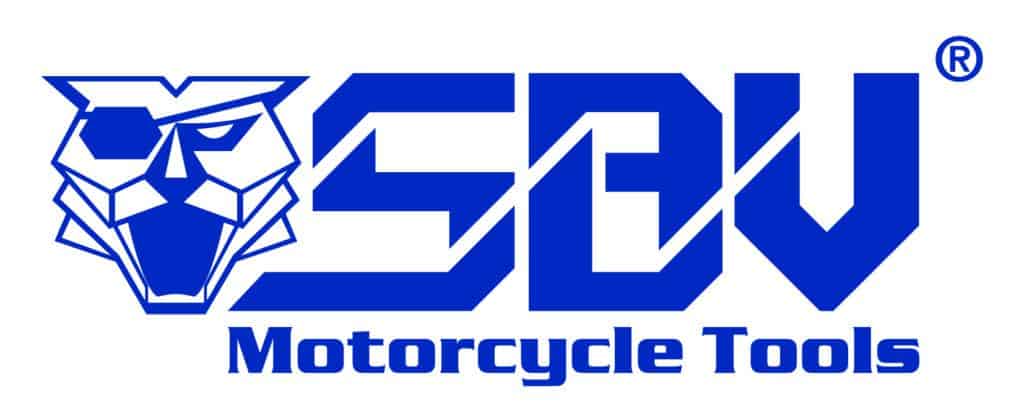
Innovative Motorcycle Tool Sets – Compact & Reliable
Used and recommended by ADVMotoSkillZ
As the bike reaches the base of the downhill slope, modulate your speed and transition into a neutral standing posture.
Be ready with your knees to absorb the bike’s suspension as it transitions from the face of the hill to the flat ground. If you are traveling with some speed, you can experience a G-out. (have link to our glossary)
Cornering on a hill
It is essential first to understand the basic body postures on hills, as reviewed above. When you feel ready to add on hill cornering skills, jump over to our ADV Motorcycle Off-Road Body Position Series – Cornering post here.
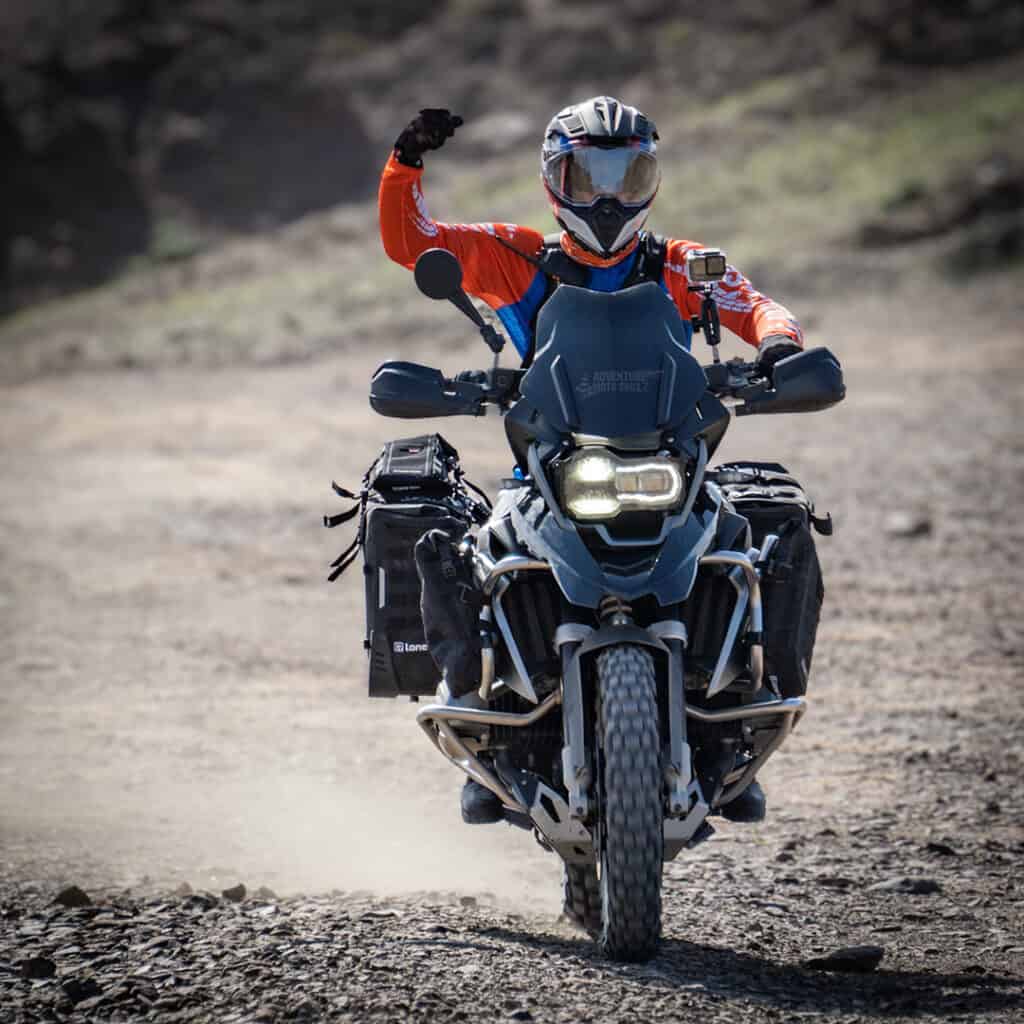
About the Author
Coach Mike is a Certified Off-Road Motorcycle Instructor & founder of ADVMotoSkillZ.
Riding tips from ADVMotoSkillZ reach thousands of international riders daily through social & blogs.
Click here to learn more about Mike’s motorcycle evolution from a Harley road rider to finding his true passion for off-road riding on a BMW 1200 GS.
If you would like to send Mike a quick message or invite him to provide training at your local facility, then visit the contact page here.
